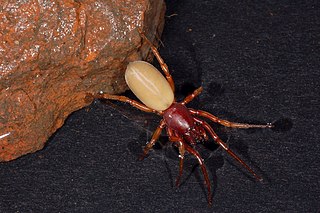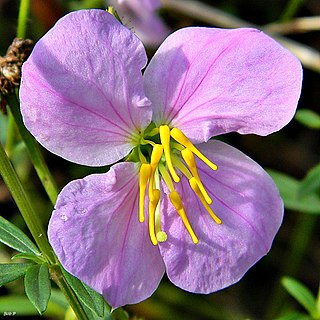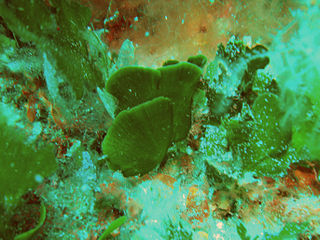
Brassicaceae or Cruciferae is a medium-sized and economically important family of flowering plants commonly known as the mustards, the crucifers, or the cabbage family. Most are herbaceous plants, some shrubs, with simple, although sometimes deeply incised, alternatingly set leaves without stipules or in leaf rosettes, with terminal inflorescences without bracts, containing flowers with four free sepals, four free alternating petals, two short and four longer free stamens, and a fruit with seeds in rows, divided by a thin wall.

Convolvulaceae, known commonly as the bindweed or morning glory family, is a family of about 60 genera and more than 1,650 species of mostly herbaceous vines, but also trees, shrubs and herbs, and also including the sweet potato and a few other food tubers.

Dysderidae, also known as woodlouse hunters, sowbug-eating spiders, and cell spiders, is a family of araneomorph spiders first described by Carl Ludwig Koch in 1837. They are found primarily in Eurasia, extending into North Africa with very few species occurring in South America. Dysdera crocata is introduced into many regions of the world.

Alliaria petiolata, or garlic mustard, is a biennial flowering plant in the mustard family (Brassicaceae). It is native to Europe, western and central Asia, north-western Africa, Morocco, Iberia and the British Isles, north to northern Scandinavia, and east to northern Pakistan and Xinjiang in western China.

Sterkfontein is a set of limestone caves of special interest to paleo-anthropologists located in Gauteng province, about 40 kilometres (25 mi) northwest of Johannesburg, South Africa in the Muldersdrift area close to the town of Krugersdorp. The archaeological sites of Swartkrans and Kromdraai are in the same area. Sterkfontein is a South African National Heritage Site and was also declared a World Heritage Site in 2000. The area in which it is situated is known as the Cradle of Humankind. The Sterkfontein Caves are also home to numerous wild African species including Belonogaster petiolata, a wasp species of which there is a large nesting presence.

Pieris oleracea, or more commonly known as the mustard white, is a butterfly in the family Pieridae native to a large part of Canada and the northeastern United States. The nearly all-white butterfly is often found in wooded areas or open plains. There are two seasonal forms, which make it distinct from other similar species. Because of climate change, populations are moving further north.

Nepenthes petiolata is a highland Nepenthes pitcher plant species endemic to Mindanao island in the Philippines, where it grows at an elevation of 1,450–1,900 metres (4,800–6,200 ft) above sea level.

Rhexia is a genus of flowering plants in the family Melastomataceae. Rhexia species are commonly called "meadow beauty" and 11 to 13 species of Rhexia have been recognized depending on different taxonomic treatments.

Rawa Aopa Watumohai National Park is a national park on the Indonesian island of Sulawesi, in the province of South East Sulawesi. It was declared in 1989, and has an area of 1,050 km². The park ranges from sea level to the altitude of 981 m. It contains the Aopa peat swamp, the largest in Sulawesi, and is recognised as a wetland of international importance.

Flabellia is a genus of green algae in the family Halimedaceae. Flabellaria is an accepted synonym of this genus. It is a monotypic genus and Flabellia petiolata is the only species; it is found in the eastern Atlantic Ocean and the Mediterranean Sea.

Amphigerontia contaminata is a species of Psocoptera from Stenopsocidae family that can be found in England, and sometimes Ireland. They are also common in countries like Austria, Belgium, Canary Islands, Cyprus, Finland, France, Germany, Greece, Hungary, Italy, Latvia, Luxembourg, Norway, Poland, Romania, Spain, Switzerland, and the Netherlands. The species are either light black or brown coloured.
Amphigerontia bifasciata is a yellowish-black coloured species of Psocoptera from Stenopsocidae family that can be found in Great Britain and Ireland. They can also be found in Austria, Belgium, Croatia, Denmark, Finland, France, Germany, Hungary, Italy, Latvia, Luxembourg, Norway, Poland, Romania, Sweden, Switzerland, and the Netherlands.
Amphigerontia intermedia is a species of Psocoptera from the Psocidae family that can be found in Finland, France, Germany, Hungary, Italy, Poland, Romania, Sweden, Switzerland, and the Netherlands. The species are either light black or brown coloured.

Garlic mustard was introduced to North America as a culinary herb in the 1860s and it is considered an invasive species in much of North America. As of 2020 it has been documented in most of the Eastern United States and Canada, with scattered populations in the west. It is listed as a noxious or restricted plant in the following states: Alabama, Connecticut, Massachusetts, Minnesota, New Hampshire, Oregon, Vermont, and Washington. A current map of its distribution in the United States can be found at the Early Detection and Distribution Mapping System (EDDmapS).
Amphigerontia montivaga is a species of common barklouse in the family Psocidae. It is found in Central America and North America.

Amphigerontia is a genus of common barklice in the family Psocidae. There are more than 30 described species in Amphigerontia.
Aradus funestus is a species of flat bug in the family Aradidae. It is found in North America.
Aradus depictus is a species of flat bug in the family Aradidae. It is found in North America.
Microchaetina petiolata is a species of bristle fly in the family Tachinidae. It is found in North America.
Paradidyma petiolata is a species of bristle fly in the family Tachinidae. It is found in North America.











